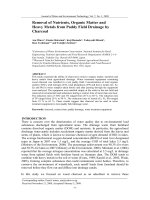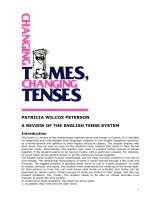chapt2 matter and change
Bạn đang xem bản rút gọn của tài liệu. Xem và tải ngay bản đầy đủ của tài liệu tại đây (305.52 KB, 30 trang )
Chapter 2
Matter and Change
What is Matter?
Matter is anything that takes up space
and has mass.
Mass is the amount of matter in an
object.
Mass is resistance to change in motion
along a smooth and level surface.
Examples
Types of Matter
Substance- a particular kind of matter pure
Mixture- more than one kind of matter
Properties
Words that describe matter (adjectives)
Physical Properties- a property that can
be observed and measured without
changing the substance.
Chemical Properties- a property that
can only be observed by changing the
type of substance.
Properties
Words that describe matter (adjectives)
Extensive Properties- only depends on
the amount of matter
Intensive Properties- only depends on
the type of matter, not the amount
Used to identify a substance
States of matter
Solid- mater that can not flow and has
definite volume.
Liquid- definite volume but takes the
shape of its container (flows).
Gas- a substance without definite
volume or shape and can flow.
Vapor- a substance that is currently a
gas but normally is a liquid or solid at
room temperature.
States of Matter
Definite Definite Temp. ComVolume? Shape? increase pressible?
Solid
Liquid
Gas
YES
YES
NO
YES
Small
Expans.
NO
NO
Small
Expans.
NO
NO
Large
Expans.
YES
Condense
Freeze
Evaporate
Melt
Solid
Liquid
Gas
States of Matter
There are more
Plasma
– high temperature low pressure
– electrons separate from nucleus
– Most common in the universe
More at very low temp
– Bose- Einstein condensate
– Quantum superfluids
Another Way to Change States
Pressure
For some substances it will turn solids
to liquids
For others it will turn liquids to solids
– Silly putty
Will turn gas to liquid– Compressor in refrigerator and AC
Physical Changes
A change that changes appearances,
without changing the composition.
Examples?
Chemical changes - a change where a
new form of matter is formed.
Also called chemical reaction.
Examples?
Not phase changes
– Ice is still water.
Mixtures
Made up of two substances.
Variable composition.
Heterogeneous- mixture is not the same
from place to place.
Chocolate chip cookie, gravel, soil.
Homogeneous- same composition
throughout.
Kool-aid, air.
Every part keeps its properties.
Separating mixtures
Only a physical change- no new matter
Filtration- separate solids from liquids
with a barrier
Distillation- separate because of
different boiling points
– Heat mixture
– Catch vapor in cooled area
Chromatography- different substances
are attracted to paper or gel, so move at
different speeds
Chromatography
Phases
A part of a sample with uniform
composition, therefore uniform
properties
Homogeneous- 1 phase
Heterogeneous – more than 1
Solutions
Homogeneous mixture
Mixed molecule by molecule
Can occur between any state of matter.
Solid in liquid- Kool-aid
Liquid in liquid- antifreeze
Gas in gas- air
Solid in solid - brass
Liquid in gas- water vapor
Solutions
Like all mixtures, they keep the
properties of the components.
Can be separated by physical means
Not easily separated- can be separated
without creating anything new.
Substances
Elements- simplest kind of matter
Cannot be broken down into simpler
All one kind of atom.
Compounds are substances that can be
broken down by chemical methods
When they are broken down, the pieces
have completely different properties
than the compound. Salt
Made of molecules- two or more atoms
stuck together
Compound or Mixture
Compound
Mixture
One kind of pieceMolecules
More than one kind Molecule or atoms
Making is a
chemical change
Making is a
physical change
Only one kind
Variable composition
Which is it?
Mixture
Element
Compound
Chemical Reactions
Another name for chemical change
When one or more substances are
changed into new substances.
Reactants- stuff you start with
Products- What you make
NEW PROPERTIES
Because each substance has its own
properties
Indications of a chemical reaction
Energy absorbed or released
Color change
Odor change
Precipitate- solid that separates from
solution
Not easily reversed
Only clues not certainty
Chemical symbols
There are 116 elements
Each has a 1 or two letter symbol
First letter always capitalized second
never
Don’t need to memorize
Some from Latin or other languages
Chemical symbols
Used to write chemical formulas
Subscripts tell us how many of each
atom
H 2O
C3H8
HBrO3
Conservation of Mass
Mass can not be created or destroyed
in ordinary (not nuclear) changes.
All the mass can be accounted for.
Mass at the start = mass at end









